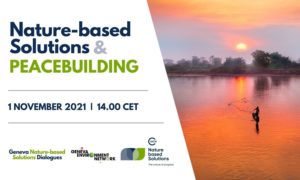Event Virtual
Nature-based Solutions and Peacebuilding | Geneva Nature-based Solutions Dialogues
The Geneva Nature-based Solutions dialogues aim to facilitate further engagement and discussion among the stakeholders in International Geneva and beyond, in the lead-up to a critical year for nature and society. The dialogues are convened by the Geneva Environment Network and the International Union for Conservation of Nature (IUCN).
About the Dialogues
We are facing a triple planetary crisis – climate change, nature loss and pollution. In this context, Nature-based Solutions (NbS) are a powerful ally to address a societal and environmental challenges. As per IUCN definition, NbS are actions to protect, sustainably manage and restore natural or modified ecosystems that address societal challenges effectively and adaptively, simultaneously providing human well-being and biodiversity benefits.
NbS are a powerful tool to facilitate and catalyse the engagement of cross-sectoral stakeholders to join forces towards the implementation of an ambitious Post-2020 Global Biodiversity Framework (GBF) and move towards achieving the CBD 2050 Vision of ‘Living in harmony with nature’. NbS also offer a pathway for synergies among several multilateral environmental agreements, including for biological diversity (CBD), climate change (UNFCCC), disaster risk reduction (Sendai Framework), desertification (UNCCD) and the wider Sustainable Development Goals (SDGs) – and for mainstreaming nature conservation into sectoral decision-making processes.
In the lead-up to a critical year for nature and society, NbS offer an opportunity to address a wide range of urgent societal challenges. The year 2021 and the major upcoming negotiations should indeed mark a turning point towards a resilient world for future generations.
Join the Geneva Environment Network and the International Union for Conservation of Nature in a one-year journey, where experts from all over the world and different sectors will discuss throughout the year how NbS are relevant to various debates ongoing in Geneva.
Other Sessions
- Nature-based Solutions and Health | 26 April
- Nature-based Solutions and Ecosystems Restoration | 7 June
- Nature-based Solutions and the Post-2020 Biodiversity Framework | 28 June
- Decent Work Through Nature-based Solution for an Inclusive Socio-Economic Recovery | 30 August
- Nature-based Solutions and Food | 13 September
- Nature-based Solutions and the Ocean | 27 September
- Nature-based Solutions for Building Resilience | 11 October
- Nature-based Solutions and Cities | 25 October
- Nature-based Solutions and Water | 22 November
- Nature-based Solutions and People | 6 December
About this Session
All too frequently, conflict is a cause for environmental degradation and natural resources depletion, leading to food and water insecurity, loss of livelihoods, and biodiversity loss among others. Competition over resources, particularly given their increasing scarcity, can also increase tensions and conflicts. At least 40 percent of all internal conflicts over the last 60 years have been linked to the exploitation of natural resources.
While the negative impact of conflict on the environment is clear, natural resources can also facilitate post-conflict peacebuilding and recovery. The protection of the environment and cooperation efforts in that direction can serve to build lasting and sustainable peace. Conversely, maintaining peace in fragile post-conflict societies requires consideration of natural resource management and governance, as conflicts involving natural resources have also been found to be twice as likely to relapse.
Therefore, Nature-based Solutions present a large potential to contribute to sustainable development and peace throughout the cycle of conflicts. Transparent and sustainable natural resource management can improve peacebuilding measures, by providing basic needs, reducing causes of tensions, and strengthening inclusive governance. By protecting the environment, NbS can contribute to address and prevent conflict-linked environmental damage as well as combat the risk of resources crisis resulting from conflict, particularly in the face of future climate stresses (IUCN, 2020).
This dialogue brought together leading experts on environmental peacebuilding to discuss how we can harness the potential of NbS in peacebuilding efforts. This session was organized ahead of the Opening Ceremony of the Geneva Peace Week 2021, a flagship initiative of the Geneva Peacebuilding Platform to foster exchange between the actors working on peace from all sectors. The environment is high on the agenda of this edition, as the global community heads towards the 2nd International Conference on Environmental Peacebuilding, to take place in Geneva in February 2022.
Speakers
By order of intervention.

Hannah MOOSA (Moderator)
Forum Deputy Manager, IUCN

Elaine HSIAO
Environment and Peace Theme Chair, IUCN Commission on Environmental, Economic and Social Policy (CEESP)

Carl BRUCH
Director International Programs, Environmental Law Institute

Alexis CAÑARI
Co-Founder of Hello World & Rapporteur for ENPAx

Wim ZWIJNENBURG
Humanitarian Disarmament Project Leader, PAX

Shanchita HAQUE
Deputy Permanent Representative, Permanent Mission of Bangladesh to the United Nations

Ulrika ÅKESSON
Senior Policy Specialist on Environment and Climate, Swedish International Development Cooperation Agency (Sida)

Caroline SEAGLE
IUCN Commission on Environmental, Economic and Social Policy (CEESP)
Summary
Welcome and Introduction
Setting the Scene | Hannah MOOSA, IUCN
- At the 2016 IUCN World Conservation Congress in Hawaii, IUCN members adopted a resolution that defined nature-based solutions as actions to protect sustainably, manage and restore natural and modified ecosystems in ways that address societal challenges effectively and adaptively to provide both human well-being and biodiversity benefits.
- Nature-based solutions offer the potential to help address critical global challenges such as climate change, human health, food and water security, natural disasters and biodiversity loss in a holistic manner. One that is grounded in the ecosystem approach and in a way that benefits both people and nature.
- Governments, communities, businesses and NGOs are increasingly embracing the NbS approach. However, there is still a misunderstanding and misuse of the concept thus harming biodiversity and communities. Therefore, n response, there is a need for a standardized approach.
- In July 2020, IUCN launched the first ever Global Standard for Nature-based SolutionsTM, a tool to help governments, communities, businesses and NGOs to implement strong and effective nature-based solutions that are ambitious in scale and sustainable to prevent misuse and safeguard both people and planet.
- The standard is the first set of coherent guidance on how to design and implement nature-based solutions. It is a crucial step in increasing clarity and precision as to what nature-based solutions encompass and how it can be successfully implemented. It also acts as a framework for learning how to improve nature-based solutions and sharing this knowledge globally in a structured manner. The standard comprises eight key criteria. For the peace building context there are two that are particularly critical.
- Criterion five requires that nature-based solutions acknowledge, involve and respond to the concerns of a variety of stakeholders, particularly rights holders. Participation is based on mutual respect and equality regardless of gender, age or social status. It requires upholding the rights of indigenous peoples to free, prior and informed consent.
Panel Discussion
Environment and peace as cross-cutting themes for conservation, sustainable development and security | Elaine HSIAO, IUCN CEESP
- Conservation is deeply linked to survival, relief from suffering, adaptation and the possibility for many to thrive that it presents a powerful nature-based solution for peace building or for creating and exacerbating tensions and conflicts between people.
- Conservation and conservation interests are threatened and impacted in many places by armed conflict or armed violence. This has escalated militarization, securitization and weapons use in conservation. We need to not only give better attention to how humanitarian and peace-building efforts and conservation efforts can be mutually supportive, but also on how conservation, humanitarian and peacebuilding actors can better support environmental defenders, indigenous and local communities living in these conflict zones. We also need to develop our skills in non-violent conflict resolution, find more compassionate alternatives to more arms and more tech surveillance and look at the violence and conflict inflicted by conservation itself.
- Conservation in the world is going to be dramatically challenged by the forces of migration and displacement in the decades to come. We need to look at how nature-based solutions can reduce human and non-human displacement, ease the suffering of displaced peoples and other species, as well as address the changing dynamics of human-wildlife conflicts and facilitate ecological regeneration and peaceful integration in places of settlement. When it comes to displacement, conservation can no longer be part of the problem if it wants to be part of the solution. Territorially defined and defended protected areas will no longer be the solution and we need to think about nature-based solutions in longer-term, multi-generational scenarios that are dynamic and adaptive; integrating peace processes in multi-species more than human ways.
- Protection of the environment or conservation through nature-based solutions could foster peace between people, between states and even between humans and the rest of life on Earth. Nature-based solutions play a powerful role in peacebuilding broadly but this is neither explicit nor automatic. We cannot assume that because it’s called a nature-based solution that peace will follow. Peace by peaceful means must be made explicit in nature-based solutions and operationalized through new forms of capacity building like training on non-violent conflict management, respect for human rights, cross-cultural collaborative problem-solving, conflict analysis, peace and conflict impact assessments, process tracking, and non-violent communication, among others. These are not inherent to conservation and it is imperative that nature-based solutions are not only conflict-sensitive but also conflict transformative to actually build peace.
Adopting a conflict-sensitive approach to Nature-based Solutions | Carl BRUCH, Environmental Law Institute
- Conflict and peace are inherently social and one of the greatest challenges for nature-based solutions is that many of the leading conservation institutions who are the leaders on nature-based solutions do not have the expertise, a mandate, or an inclination to focus on conflict. As a result, many of them are not conflict-sensitive and we have seen some very unfortunate results from this.
- The Environmental Law Institute conducted an evaluation for the Global Environment Facility (GEF) of the design, implementation, monitoring and evaluation of its projects in fragile and conflict defective situations. GEF is a major funder of conservation work. It has supported more than 4,000 projects and 88 of the country-level projects occur in fragile environments. As of July 2020, GEF had invested USD 4 billion in countries affected by major armed conflicts.
- When we looked at the effect of conflict and fragility on the performance of GEF projects, we saw that conflict and fragility had a statistically significant impact on a project being canceled or dropped, as well as the increased duration of delays. This is fairly expected but what we were surprised by was that fragility had a statistically significant impact on every performance indicator. One of the most important ones is sustainability, the sustainability of the benefits after the project is done. Too often, we go back to normal and it did not have a lasting impact.
- When we did the analysis, GEF had no policies on conflict and sensitivity. It relied on implementing agencies, and only half of them have developed policy strategies and toolkits on conflict and sensitivity. In the absence of official guidance, implementing agencies have been innovating to meet the needs of their operating environments.
- There are five major ways that projects approach conflict: 1) sensitivity is an acknowledgment that there is conflict, 2) avoidance such as if the project is in a biological hot spot where the conflict is, doing it away from the conflict isn’t going to help that biodiversity, 3) mitigation is related to monitoring, evaluation, and the engagement of communities and local partners, 4) embracing the peacebuilding opportunities, and 5) learning.
- Nature-based solutions need to be conflict-sensitive if they are to achieve their environmental objectives and there are two general approaches: 1) support the peace process by focusing on particular peacebuilding objectives, livelihoods, basic services, and peace dividends and 2) seek to transform the conflict.
- It’s important to note that just because we are doing nature-based solutions and pursue peace doesn’t mean that we can’t have a negative effect on conflict and peace if we’re not careful about how we do it.
Youth Perspectives on Positive Peace: Outcomes of the IUCN Youth Summit | Alexis CAÑARI, Hello World & ENPax
- The outcomes from the IUCN Youth Summit focused on how young people are integrating positive peace in conservation actions. We are not only accepting that peace is only the absence of direct violence, but rather that we are working to deconstruct structural situations and relationships that cause harm or conflict, for example, with nature.
- We are also trying to develop actions and initiatives on the ground with the presence of equity, justice or sustainability. Young people show a clear understanding of the urgent need to restore meaningful relationship between humans and for reaching positive peace. We are looking to move from this anthropocentric approach to a more eco-centric approach and to have environmental ethics in all the actions that we are trying to develop.
- Having all these ecological environmental damages, it’s important to remark that positive piece makes it possible to build more resilient societies that can face not only the current challenges but also future ones.
- Some key priorities from the IUCN Youth Summit include the necessity to build a more transformative and inclusive education we if we want to reach sustainable peace. Unfortunately, mainstream education fails in incorporating environmental and ecological citizenship. We also have a huge digital divide and linguistic barriers in which we are losing a huge opportunity to have more voices from around the world on the table of discussion. For example, English is not the language of conservation and we are hoping that there will be more spaces where people can feel comfortable to share their ideas in a safe place. When we are trying to build this transformative and inclusive education, we are also giving a space to create a community that accept the right of others.
- To accept the rights of nature, recognizing that humans equally deserve rights and freedom, is to accept the rights of Indigenous Peoples and ethnic minorities because, unfortunately, they have few legal protection. It can be connected to the protection of environmental activists that are being assassinated in different in countries. In addition, when we are trying to implement solutions, we need to respect visions from other communities as this will allow us to create a more holistic solution.
The Impact of Conflict on the Environment | Wim ZWIJNENBURG, PAX
- Over the last six years, we’ve been working to improve data collection and monitoring to demonstrate how damage to the environment has an impact on civilians and to include this in the agenda and protection of civilians and protection of the environment.
- We’ve seen that the impacts of conflict on the environment has serious implications on human health, livelihoods and ecosystems. Through novel research methods, what we’re trying to build over these last years by using remote sensing data and open source information is to have a more coherent picture on a more granular level of how those impacts happen, what should be done to address those impacts either through you, advocacy in the United Nations or supporting work by the ICRC and other international organizations who’ve been building policies on that.
- What we’ve come across in in our work is that every conflict has unique features. In Syria, we see massive destruction of oil infrastructure and deforestation. In Iraq, we have also seen oil fires and damage to nature reserves. Impacts on agriculture and larger problems around solid waste management and the general collapse of environmental governance have both a huge risk for people, a long-term risk for ecosystems and climate resilience.
- When the topic of nature-based solutions was raised in the discussion leading up to UNEA, we felt this is a great example of demonstrating that we don’t only see negative consequences on people but also on the environment. There are opportunities to address this already either through humanitarian response or by supporting local groups and civil society groups. We can also look at green unitarian response and dealing with debris from cities and building back greener and better in urban areas affected by conflict. Leading up to UNEA, it’s important that States include this in discussions around nature and conflict in relevant resolutions.
Experience and Efforts for Nature-based Solutions for the Purpose of Peacebuilding | Shanchita HAQUE, Permanent Mission of the People’s Republic of Bangladesh in Geneva
- The relation between natural resources and peacebuilding is complex and multifaceted. Inequality in access to natural resources, as well as its management, undermines welfare, affects human security and creates risk of conflict and peacebuilding activities. We do not only aim to end conflict but also to create structures that contribute to adjusting and sustaining peace.
- The management of natural resources is an integral part of the peacebuilding process. Integrating nature-based solutions with the development programs offers sustainable, economically viable and acceptable options to support resilience of infrastructure in urban and rural areas, livelihoods, water health, food security and promote inclusivity.
- Bangladesh has its own experience of how nature-based solutions can offer social inclusion and economic prosperity. Our experience in our country’s southern part where we have a large mangrove forest has a lot to offer when it comes to achieving the SDGs and addressing property. It contributes millions of dollars to our economy through tourism, provides livelihood to hundreds of thousands of local community people, and saves millions of dollars in reconstruction and recovery by shielding the coastal areas from natural disasters. In the area of Bangladesh and India where we share this natural heritage, it represents a single ecosystem divided between these two countries. Both recognize the need to monitor and conserve the area, home to rich biodiversity and consists of a large variety of rare species of flora and fauna. We recognize that this mangrove forest acts as a vital protective barrier protecting the mainland from flooding tidal waves and cyclones. Most of the people living in this area depend heavily on these natural resources for livelihood, energy, medicinal plants, food supplies, in addition to vital inputs and services to small-scale agriculture. Bangladesh and India signed an MOU in 2011 that provides guidance to adopt appropriate joint management and monitoring of the resources, conservation and protection efforts, and to encourage mangrove regeneration and habitat restoration. The MOU keeps the scope for developing a long-term strategy for creating eco-tourism opportunities for both countries, which will ultimately create synergy and generate greater revenue. This is an excellent example of using nature-based solutions in addressing drivers of instability, thus, helping sustain peace in communities and among the countries.
- Bangladesh is also currently the top contributing country in terms of troops in the UN peacekeeping missions for its commitment to environmental management in peacekeeping missions. Bangladesh co-founded the group of friends for leading environmental management in the field, along with Italy. The group started its activities in February 2018 with the aim to raise awareness on the importance of managing the environmental footprint of operations in the field. The group also supports the implementation of the environmental strategy of the event launched by the Department of Operational Support in 2016, which is now being implemented. Bangladeshi peacekeepers are supporting the implementation of the environmental strategy, including engaging with the communities. We also encourage the use of jute and other fiber-based products as an alternative to plastics.
- Failure to respond to the environmental needs of post-conflict societies can greatly complicate the already difficult tasks of peace reconciliation, institutional building and economic reconstruction. Decisions about the restoration and protection of natural resources have fundamental implications for short-term stability, long-term sustainable development and, therefore, successful peacebuilding.
A Donor Perspective on Environmental Peacebuilding: Challenges, Opportunities, Policy- and Decision-Making | Ulrika ÅKESSON, Sida
- Nature-based solutions are part of our environmental and peacebuilding work. Along with the environment and conflict sensitivity, three other perspectives are to be integrated: human rights based approach, gender equality, and people living in poverty.
- People living in poverty are agents of change and can express their needs, interests and preconditions. They are also rights holders with legal entitlements and can hold duty barriers accountable to comply with commitments, including international commitments and obligations within the fields of environment and peace. Environmental strategies and actions need to take conflict sensitivity seriously and peace processes and agreements need to integrate environmental concerns.
- The vision is for Stockholm+50 is to promote international collaboration for accelerating a just and inclusive transition that leaves no one behind. There is a potential for Stockholm+50 to serve as a platform for driving implementation related to the 2030 agenda, the Paris Agreement and other international agreements like women, peace and security. To use peace and security to steer towards development that reduces inequalities and benefit people living in poverty and conflict.
- Early warning signals of, for example, climate change as a risk multiplier for violent conflict that should trigger early preventive actions needs to go hand in hand with more locally-led conflict-sensitive action for the environment, as well as environmental and climate-sensitive conflict prevention and peacebuilding, and the broad involvement of women and men who are most affected by climate change, biodiversity loss and conflict. Being agents of change may strengthen conflict sensitivity.
- Nature-based solutions in agroforestry that we support have been used for centuries to improve food security and livelihoods while sustainably managing ecosystems and their functions such as biodiversity and ecosystem service delivery. As an environmental peacebuilding intervention, it can support, for example, migrants and rural households by very concretely supporting knowledge of transfer, supporting incentives to invest in long- and short-term agroforestry practices. To support natural resource management, climate change and conflict combined within the scope of international peacebuilding, we work on the global, regional and local levels by providing research and analysis of the interactions between environment, resource management and conflict issues. Through partnerships, we have created an early warning tool on water conflicts that uses machine learning to predict where conflicts are likely to occur.
The stories and voices of environmental defenders across the globe | Caroline SEAGLE, IUCN CEESP
- In 2020, approximately 331 human rights and environmental defenders were killed. This is the largest number we’ve seen so far and comes from frontline defenders. It’s also backed up by data from global witnesses. The vast majority of these defenders depend on land and the environment for their livelihoods. The greatest threats come from extractive industries – over 30% from mining specifically, but also logging, palm oil and large-scale agricultural expansion. Conservation can also create conflicts that pose a threat to local and indigenous communities.
- IUCN-CEESP recently launched a three-volume special issue on the topic of environmental defenders. The first volume focused on providing an overview of the current situation of defenders worldwide. We had contributions from environmental defenders themselves but also scholars, activists, artists and poets.
- The pandemic made the situation of environmental defenders worse and there is a greater need for more research to be done on case-by-case study so that we can better understand what the situation is.
- Climate activist and environmental defender Hindou Oumarou Ibrahim outlined three calls to action in the special issue of IUCN’s Policy Matters. These are: The criminalization of defenders must stop and no one should be killed, assaulted, driven from the land of their ancestors or simply marginalized for standing up for the most precious common good of life. Environmental defenders need dedicated support, resources, intelligence and funding to be able to act. Climate policies and actions also need to be more participatory, from design to implementation, which means improving indigenous participation in decision-making.
- Scholar, activist and environmental defender Manuela Picq also contributed to the special issue, outlining an additional three calls to action for the conservation community in order to promote greater protection for environmental defenders. She noted that, in 2021, a representative of the International Indigenous Peoples Forum on Climate Change asked the UN to fully integrate the rights of indigenous peoples in climate action in preparation for COP26. The inclusion of human rights and climate change initiatives must be a top priority in climate negotiations and climate action. International laws must be enforced so as to require, at a minimum, the free, prior and informed consent of local communities for any land project, including conservation projects on indigenous and local populations’ territories, whether formal land title is held or not. The consent must be given by indigenous and local people for mining and other mega projects as well as conservation. We must learn to protect local communities’ ways of life and their situated relationships with the environment in which they live, learning from their example so that they can continue to protect biodiversity through their own environmental management knowledge transmission and cultural values embedded in their languages and ways of life.
- As we all work together as an IUCN community to promote conservation of nature and diverse valuations of biodiversity, and in order to further protect Indigenous and environmental defenders’ rights, it is important to pay attention to power relationships in the conservation world. While different stakeholders (defenders, conservationists, researchers, practitioners, private sector) might use the same language of “Nature-based Solutions,” they may mean different things. Some Indigenous peoples might think of IPLCs living in their territory as the “Nature-based Solution.” Meaningful and inclusive dialogues with IPLCs must occur if the rights of environmental defenders are to be recognized.
Q&A
Could you reflect further on what you believe can be done to strengthen endeavors to utilize nature-based solutions to facilitate peacebuilding?
Shanchita: Several issues required our active consideration to strengthen the endeavor to place nature-based solutions at the center of peacebuilding efforts. First, smart and sustainable natural resource management in social, environmental and economic contexts can help prevent conflicts. Second, there are many challenges, even on human rights as defenders are losing their lives, for the cause of nature-based solutions. The rights of local people over natural resources must be recognized and lack of such rights can have a significant contribution to recreating or accelerating attention and conflicts. Partnership with national authorities need to ensure inclusivity, particularly of women, youth, indigenous people in all institutional and legal processes. Third, international actors can help to bridge differing group perspectives and interests on managing natural resources in conflict and post-conflict areas. Fourth, peacebuilding can support exchange of goods and practices regarding nature-based solutions through multi-stakeholder partnerships and networking. The importance of building strong partnerships in support of national priorities must be emphasized. Finally, predictable and sustained financing is important for building and sustaining peace, increase sustained and coordinated mobilization of finances, including creating awareness and capacity building for developing expertise in nature-based solutions.
What do you believe future actions which donors should take to help take environmental peacebuilding forward?
Ulrika: I want to stress that unless systems and processes for peaceful management of keeping competing interests and tensions are robust and relevant enough to deal with the difficulties in coping with climate change or loss of biodiversity, such tensions could contribute to fueling violence, especially when combined with inequality between groups. Violent conflicts cause human suffering and material destruction and poses serious obstacles to human development, as well as potentially to progress in terms of environmental actions. Environment strategies and actions need to take conflict sensitivity seriously and ensure to minimize negative impact on conflict and maximize the positive impact on peace. Falling short of that means not only running the risk of doing harms in terms of undermining peace and fueling violence, but also undoing the results that environmental strategies. Peace processes and agreements need to integrate environmental and climate concerns so that they contribute to building societies that are able to sustain peace in the face of challenges to human security caused by climate change and biodiversity loss.
From the youth perspective, what do you think is the way forward and how can nature-based solutions help in any way in advancing this work?
Alexis: It’s important to highlight that for all kind of solutions that we are trying to implement, it’s important to respect and have increased inclusion. There are many solutions that can be developed with local communities and we need to be aware that they already have knowledge to share. We need to be respectful and develop solutions with them, instead of imposing our solutions.
What part of the system do you see capacities being of most importance and who would be delivering this capacity building in terms of nature-based solutions?
Elaine: The most important part of this whole conversation is how do we actually operationalize all the things that we’re talking about. In terms of where does it sit in the system, it needs to be embedded in every aspect from the very get-go and sometimes that includes whether or not the peoples developing the nature-based solutions have a relationship with the people and the partners in the places of work, whether they’re the ones who need to be delivering the intervention in the first place. This needs to happen in places where there is ongoing armed conflict and it is going to matter whether or not those natural resources and the environment can play a role in the post-conflict peacebuilding process. There are a lot of conservation organizations and local communities who are working, sometimes engaging with armed actors out of necessity and we’re not trained for that. For environmentalists or conservationists, we need to be thinking about where we are lacking in peacebuilding and conflict resolution skills to look for the capacity building that we need to get there.
How do you ensure avoidance is not the go-to strategy and how is environmental peacebuilding working to address this issue?
Carl: It’s hard to ensure that they don’t do it. The most important thing is to educate people about why avoidance might not be a good strategy and it has to do with what your objectives are. If they are biodiversity conservation or making sure that forests aren’t cut down to mitigate climate change, you have to go where the resources are. You have to engage. In some cases, it may really not be feasible and you have to avoid. We need to reduce the use of that by focusing on the objectives and strategies other than avoidance, for example, risk mitigation.
Concluding Remarks
Caroline: The global situation of environmental defenders is one of the most important topics today. Nature-based solutions are being promoted globally as one of the top solutions that we should be paying attention to but we absolutely must consider the fact that we’ve had more deaths of environmental defenders in 2020 than any other year. For this, we need new global partnerships and greater attention to the people on the frontlines.
Ulrika: The untapped potential in peacebuilding to contribute to protecting the environment and combating climate change needs to be further explored as well as the potential in environmental work to contribute to peace. Positive environmental and climate action is really needed and this potential could be pushed by strengthening collaboration across sectors in conflict to reduce the risk of conflict, minimize its impact and harness environmental peacebuilding.
Elaine: We need to transition from conflict afflicted environments and, hopefully, somewhat conflict-sensitive conservation to non-violent and conflict transformative conservation. That means that peacebuilding needs to become an integral part of the practice and the culture of conservation – building non-violence and peace processes overtly into NbS standards, its operationalization and in the capacity-building of its actors.
Shanchita: Natural resources and peace are complementary. There must be legal and administrative systems in place to protect the environmental defenders and there must be inclusivity in the whole arrangement so that peacebuilding and natural resources are seriously addressed.
Wim: The international community must work to limit the acute and long-term environmental impacts of wars and actions for nature, including nature-based solutions, to prevent, mitigate, minimize and remediate those impacts. Not only would they support environmental restoration of efforts that better protect civilians addressing the environmental dimensions of armed conflict, including when using nature-based solutions, they are also elementary in building resilience to the compounding impacts of the climate crisis in conflict affected states.
Alexis: The youth of today are living with the challenges of increasing extreme weather conditions, scarcity and other challenges. We will continue to do so for many years. In the near future, we will also be the leading decision makers for handing of these challenges. It is important that governments, private entities, international organizations and other organizations can support youth initiatives to push them not from this consultation area but to decision making processes. We need to be open and be inclusive in each and every project that we are trying to develop and receive different kinds of knowledge. Let’s create this safe space for all.
Carl: Seeing the visual of what are nature-based solutions and what are the standards, that was really helpful because there are a lot of people talking about nature-based solutions without having a common frame of reference. This goes to some of the questions around language. Getting that framing out there would really help. We talked about a number of different approaches, building back better, managing debris, livelihoods, conflict transformation, and nature-based solutions to reduce displacement but what I think is most important is not what is the solution what we’ve been talking about but how do we go about nature-based solutions. It’s important to reflect on that, whatever solution you’re talking about. We need to make sure that’s inclusive of indigenous communities, youth, gender, local people, ethnic minorities and language. I appreciate the fact that we are speaking in English but if we want to make this work, we need to figure out solutions that goes to something that hasn’t been said, which is where the resources for this is. It’s very easy for us to say we need to be inclusive, we need to protect people from retaliation, we need to be speaking the same language. But there are very real resource constraints and how do we actually make this work.
Video
In addition to the live WebEx and Facebook transmissions, the video is available on this webpage.
Documents
Links
The update on Nature-based Solutions provides relevant information and the most recent resources, news and articles from the various organizations in international Geneva and other institutions around the world.
- Geneva Peace Week 2021 (1-5 November 2021)
- 2nd International Conference on Environmental Peacebuilding (2-4 February 2022) | Environmental Peacebuilding
- Environment, climate, conflict, and peace | Geneva Peacebuilding Platform
- Conflict and Conservation | IUCN
- White Paper on the Future of Environmental Peacebuilding | Geneva Peacebuilding Platform
- Nature-based Solutions Vital to Mitigating Conflict-linked Environmental Damage | Wim Zwijnenburg | New Security Beat | 18 February 2021
- The Road to Geneva – Environmental Peacebuilding | Geneva Environment Network | regularly updated
- Protecting the Environment in Armed Conflict | Geneva Environment Network | regularly updated

